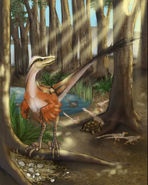(Adding categories) |
m (Updating categories: added Theropoda) |
||
| (28 intermediate revisions by 8 users not shown) | |||
| Line 1: | Line 1: | ||
| − | [[File: |
+ | [[File:Life reconstruction of Dineobellator notohesperus.png|thumb|261x261px]] |
| − | '''''Dineobellator''''' ( |
+ | '''''Dineobellator notohesperus''''' (meaning "Diné warrior") is a genus of dromeosaurid dinosaur that from the Late Cretaceous Ojo Alamo Formation of New Mexico. Its name comes from Diné, the Navajo word for their own people, and the Latin word "bellator," meaning "warrior." |
| + | |||
| + | The holotype remains were first recovered in 2008, with additional material being discovered in 2009, with the remains being described as a new genus in 2020. ''Dineobellator'' was around 2 meters (6.6 feet) in length and is believed to have weighed about 18 to 22 kilograms (40 to 49 lbs). |
||
| + | |||
| + | Unique features of the skeleton suggest greater hand and feet flexion than normal for dromaeosaurs, a tighter grip strength in the manual unguals, and greater movement at the tail base. These may have aided in agility and predation. ''Dineobellator'' is a member of the family [[Velociraptorinae]], with its presence, along with that of ''[[Acheroraptor]]'' and ''[[Dakotaraptor]]'', suggesting that dromaeosaurs were still diversifying by the end of the Cretaceous. |
||
| + | |||
| + | ==Discovery and naming== |
||
| + | The fossil remains of Dineobellator were first discovered in 2008 at the Ojo Alamo Formation. |
||
| + | |||
| + | ==Description== |
||
| + | Dineobellator was around 2.5-3 meters (8.2-9.8 feet) in length and weighed about 25 to 40 kilograms (55 to 88 lbs). |
||
| + | |||
| + | ==References== |
||
| + | |||
| + | * https://www.nature.com/articles/s41598-020-61480-7 |
||
| + | * https://www.inverse.com/science/meet-dineobellator |
||
| + | * http://www.sci-news.com/paleontology/dineobellator-notohesperus-08269.html |
||
| + | * http://www.stevenjasinski.com/dineobellator-notohesperus.html |
||
| + | * https://www.researchgate.net/figure/Skeletal-reconstruction-of-Dineobellator-notohesperus-gen-et-sp-nov-SMP-VP-2430-with_fig2_340216705 [Skeletal Reconstruction] |
||
==Gallery== |
==Gallery== |
||
<gallery> |
<gallery> |
||
Dineobellator nest.png |
Dineobellator nest.png |
||
| − | + | Dddddd.jpg|A skeletal reconstruction of ''D. notohesperus'' |
|
EUHv--sXQAY Xj .jpg |
EUHv--sXQAY Xj .jpg |
||
| + | Terror of the cretaceous skies by tyrannoninja de69xf5.jpg |
||
| + | Fauna of the Ojo Alamo Formation.png |
||
</gallery> |
</gallery> |
||
| + | |||
| ⚫ | |||
| + | |||
| + | |||
[[Category:Cretaceous dinosaurs]] |
[[Category:Cretaceous dinosaurs]] |
||
[[Category:Dinosaurs of North America]] |
[[Category:Dinosaurs of North America]] |
||
| − | [[Category:Extinct |
+ | [[Category:Extinct fauna of North America]] |
| − | [[Category: |
+ | [[Category:Extinct fauna of North America]] |
| + | |||
| ⚫ | |||
[[Category:Dromaeosauridae]] |
[[Category:Dromaeosauridae]] |
||
| + | |||
| ⚫ | |||
| − | [[Category:Extinct |
+ | [[Category:Extinct fauna of New Mexico]] |
| + | |||
| ⚫ | |||
| + | |||
| ⚫ | |||
[[Category:Feathered dinosaurs]] |
[[Category:Feathered dinosaurs]] |
||
[[Category:Cretaceous theropods]] |
[[Category:Cretaceous theropods]] |
||
| − | [[Category: |
+ | [[Category:2020]] |
[[Category:Incomplete fossils]] |
[[Category:Incomplete fossils]] |
||
| + | [[Category:Small Carnivores]] |
||
| + | [[Category:Small Carnivores]] |
||
| + | [[Category:Carnivorous dinosaurs]] |
||
| + | |||
| + | |||
| + | [[Category:Maastrichtian Fauna]] |
||
| + | [[Category:Maastrichtian Reptiles]] |
||
| ⚫ | |||
| + | [[Category:K/T Extinctions]] |
||
| ⚫ | |||
| + | [[Category:Extinct fauna of the United States]] |
||
| + | [[Category:Extinct Fauna]] |
||
| ⚫ | |||
| ⚫ | |||
| ⚫ | |||
| + | [[Category:Theropoda]] |
||
| + | [[Category:Theropoda]] |
||
Latest revision as of 16:06, 4 April 2024
Dineobellator notohesperus (meaning "Diné warrior") is a genus of dromeosaurid dinosaur that from the Late Cretaceous Ojo Alamo Formation of New Mexico. Its name comes from Diné, the Navajo word for their own people, and the Latin word "bellator," meaning "warrior."
The holotype remains were first recovered in 2008, with additional material being discovered in 2009, with the remains being described as a new genus in 2020. Dineobellator was around 2 meters (6.6 feet) in length and is believed to have weighed about 18 to 22 kilograms (40 to 49 lbs).
Unique features of the skeleton suggest greater hand and feet flexion than normal for dromaeosaurs, a tighter grip strength in the manual unguals, and greater movement at the tail base. These may have aided in agility and predation. Dineobellator is a member of the family Velociraptorinae, with its presence, along with that of Acheroraptor and Dakotaraptor, suggesting that dromaeosaurs were still diversifying by the end of the Cretaceous.
Discovery and naming
The fossil remains of Dineobellator were first discovered in 2008 at the Ojo Alamo Formation.
Description
Dineobellator was around 2.5-3 meters (8.2-9.8 feet) in length and weighed about 25 to 40 kilograms (55 to 88 lbs).
References
- https://www.nature.com/articles/s41598-020-61480-7
- https://www.inverse.com/science/meet-dineobellator
- http://www.sci-news.com/paleontology/dineobellator-notohesperus-08269.html
- http://www.stevenjasinski.com/dineobellator-notohesperus.html
- https://www.researchgate.net/figure/Skeletal-reconstruction-of-Dineobellator-notohesperus-gen-et-sp-nov-SMP-VP-2430-with_fig2_340216705 [Skeletal Reconstruction]


